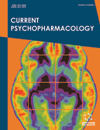- Home
- A-Z Publications
- Current Psychopharmacology
- Previous Issues
- Volume 2, Issue 3, 2013
Current Psychopharmacology - Volume 2, Issue 3, 2013
Volume 2, Issue 3, 2013
-
-
Pharmacological Treatments for Behavioral Addictions: From Behavioral Dimensions to the Research Domain Criteria Based Target
More LessAuthors: Stefano Pallanti, Giacomo Grassi, Tommaso Tofani and Silvia SpitoniSeveral patterns of maladaptive behaviors share their clinical features with those of substance use disorders such as tolerance, withdrawal, repeated unsuccessful attempts to cut back or quit, and interference in major areas of life function, thus gaining the name of “behavioral addictions”. Several studies showed that behavioral addictions and substance addictions share a similar pattern of brain activation durin Read More
-
-
-
Psychobiological Model of Personality: Guidelines for Pharmacotherapy of Personality Disorder
More LessAuthors: Dragan M. Svrakic and Robert C. CloningerModern psychobiological theory conceptualizes personality as a self-organizing, complex adaptive system involving a bi-directional interaction between heritable neurobiological dispositions to behavior (temperament) and developing concepts about self and external objects (character). Since its introduction in 1993, the Psychobiological Model of Temperament and Character (aka the Seven Factor model) has become one Read More
-
-
-
Update on the Pharmacological Treatment of Pathological Gambling
More LessAuthors: Scott A. Bullock and Marc N. PotenzaThis is an update to a previously published article discussing the neuropsychopharmacology of pathological gambling (PG) [1]. In the prior manuscript, we described how cortico-limbic circuitry and neurotransmitter systems (norepinephrine, serotonin, dopamine, opioids, glutamate, and gamma-aminobutyric acid (GABA)) have been implicated in PG. These systems represent potential targets for psychopharmacological tr Read More
-
-
-
Antipsychotics Management in Addictive Disorders
More LessAuthors: Pierre Alexis Geoffroy, Benjamin Rolland, Vincent Laprevote and Olivier CottencinSeveral authors have hypothesized that antipsychotics could down-regulate the activation of dopamine receptors in the mesolimbic pathway, thus decreasing the occurrence and the intensity of addiction-related symptoms. We conducted a critical review of the theoretical arguments that have been published on this subject and evaluated how they compare to the published clinical data. Despite interesting findings, the effects of Read More
-
-
-
Stimulant-Related Psychosis in ADHD Treatment: An Update for Past 10 Years
More LessAuthors: Gresa C. Bulut, Seheryeli Y. Kaynar and Osman SabuncuogluAlthough it is considered rare, stimulant-induced psychosis is one of the most serious and unpleasant adverse events during attention deficit/hyperactivity disorder (ADHD) treatment. There is a need to update regularly the current state of knowledge on this topic to improve quality of care. For this reason, we reviewed relevant publications using Pubmed database, for the period 2003-2012. It came out that the amo Read More
-
-
-
Acute Methamphetamine and Benzylpiperazine Decrease Aggression- Related Behavior in Late Adolescent Male Rats
More LessAuthors: Hamish N.L. Johnson and Robert N. HughesThe effects on aggression in late adolescent male rats of acute administration (via intraperitoneal injection) of 10 or 20 mg/kg of the designer drug, benzylpiperazine (BZP), were assessed in comparison with 1 or 2 mg/kg of methamphetamine (MA). The two drugs are very similar in their behavioral and neurochemical effects. Aggression was measured with the resident/intruder test of aggression which involves recording Read More
-
-
-
Nicotine and Tobacco Particulate Self-Administration: Effects of Mecamylamine, SCH23390 and Ketanserin Pretreatment
More LessAuthors: Katharine A. Brennan, Fraser Putt, Vicky Roper, Uta Waterhouse and Penelope TrumanAqueous tobacco particulate matter (TPM) is a tobacco smoke extract that contains nicotine and a number of other smoke constituents, thus TPM self-administration in rats might better represent the more complex pharmacological effects of smoke. The present study sought to examine the effects of several receptor antagonists on nicotine and TPM self-administering rats to compare underlying neurochemical systems involv Read More
-
-
-
Maintenance CBT in Preventing Relapse in Patients on SSRI Continuation
More LessThe utility of cognitive-behavioral therapy in the treatment of acute depression has been well established. It is frequently employed with antidepressants acutely to yield greatest efficacy. While it is frequently stated that the techniques of CBT learned during acute treatment are enduring, there is little data suggesting that this is true. We studied 327 patients over a 13 year period in a community clinic who respon Read More
-
-
-
The Anabolic Androgenic Steroid Testosterone Propionate Decreases Recognition Memory in Adult Male Rats
More LessAlthough there are therapeutic applications of the Anabolic Androgenic Steroids (AAS), the predominant use implies the illicit self-administration by athletes and adolescents. In this respect, AAS abuse is associated with untoward effects on brain and behavior. Exposure to supraphysiological doses of AAS leads to changes in anxiety and aggression, but their effects on cognitive functions are poorly understood. We investigated Read More
-
-
-
Immobilization-Induced Behavioral Deficits are Attenuated But Coping with Repeated Stress Impaired in Apomorphine Injected Rats
More LessAuthors: Darakhshan Jabeen Haleem and Huma IkramApomorphine a non-narcotic derivative of morphine acts as a dopamine agonist to produce psychostimulant effects. Currently, apomorphine is used in patients with advanced Parkinson’s disease, for the treatment of persistent and disabling motor fluctuations which do not respond to levodopa or dopamine agonists. There is growing evidence that Parkinson’s disease patients treated with apomorphine develop an addic Read More
-
Most Read This Month
Article
content/journals/cpsp
Journal
10
5
false
en


